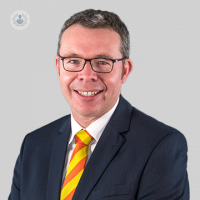Prostate cancer: what happens during a robotic prostatectomy?
Autore:Robotic-assisted laparoscopic prostatectomy (RALP) is an operation where the prostate gland is removed via small keyhole cuts rather than large incisions. The surgeon is using a robot (the da Vinci® surgical system) for extra precision. We were fortunate to ask one of our leading urological surgeons Mr Aidan Noon what happens exactly during the procedure used to treat prostate cancer and what you can expect during recovery.

How is RALP performed?
Generally, the procedure is carried out using a general anaesthetic and takes approximately three hours to complete. The majority of patients will go home the next day. What is unusual about this operation is the position that the patient is placed.
Most centres will require a degree of tilting the patient head down, which helps to keep the bowel out of the surgical field and allows the instrument and camera to access the prostate. This head-down position is one contributing reason why some patients may not be suitable for RALP (for example in patients who are very overweight, or with some eye conditions or sometimes because of heart and lung problems).
The first part of the operation requires the surgeon and his assistant to safely insert the keyhole instruments and camera into the abdominal cavity. This occurs via small incisions around the level of the belly button. The theatre and anaesthetic team then supervise the head-down position of the patient and then the robotic instruments are inserted via the “keyhole” ports.
The surgeon then sits at the robot console and performs the operation as an assistant is next to the patient to help change the instruments and provide help with parts of the procedure that can’t be completed by the instruments alone. This may include sucking out blood that is obscuring the view, cleaning the camera and applying surgical clips if needed et al.
Once the prostate has been surgically removed the surgeon will then carefully suture the bladder to the water pipe. A catheter (tube via the penis into the bladder) is placed to keep the bladder empty and to promote healing of the join.
The catheter is removed after a few days. The incision above the belly button is enlarged to allow the prostate to be removed (in a special bag), the incisions are closed with stitches and dressings applied.
What is short-term and long-term recovery like following RALP?
Due to the minimally invasive nature of the operation patients will resume eating and drinking the day of their operation. Patients will be encouraged to sit out of bed and mobilise as soon as the effects of the anaesthetic have worn off.
The first postoperative day, patients are walking around in preparation to be discharged home. Most patients will be fully back to their pre-operative levels of fitness by six weeks, which may be sooner for younger and fitter patients.
Recovery of urinary continence again is patient-specific, some patients are dry from the moment the catheter is removed, the majority will require some form of pads achieving a satisfactory level of continence at different time points out from surgery.
It is worth mentioning that RALP still represents pelvic surgery and there will be some patients that have complications that will require further treatment. Thankfully the major complication rate from RARP is rare.
READ MORE: HOW TO PREPARE FOR RALP
Mr Noon is a highly experienced urologist in Sheffield who treats patients with prostate, bladder and testicular cancer as well as other common urological problems such as blood in the urine and high PSA. You can book an appointment to see him via his Top Doctor’s profile here.


